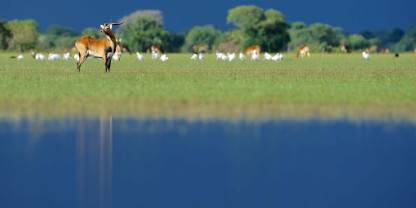Average Expert Rating
Rating Breakdown
Write a User ReviewHome to the shoebill
The southern floodplains of Bangweulu can be explored in a 4x4 during the Dry season. The most prolific large mammal here is the black lechwe, the most handsome of the three extant subspecies of this semi-aquatic antelope. Although the black lechwe’s range is restricted to Bangweulu, it is locally very common, and we saw several herds numbering 100-plus individuals.
Read more
Other large mammals present in Bangweulu include elephant, buffalo, hippo, zebra, tsessebe, and roan and sable antelope, but we didn’t see any of them, and frankly they are very unlikely to be encountered on a casual visit. Cheetahs have been reintroduced, and since they are radio-collared, they are quite likely to be seen if you ask the rangers for coordinates.The main attraction of Bangweulu is its prolific birdlife. It is known particularly for hosting Africa’s most southerly population of the shoebill, a bizarre avian heavyweight notable for its massive clog-shaped beak and eerie gray feathering. Bangweulu is estimated to support around 500 shoebills (around 10% of the global population of this vulnerable species), but they tend to retreat deep into the swamps during the Dry season, and are far more likely to be seen when the water is at its highest, from around January to June.
Although we took a dugout trip into the swamp, we were there at the wrong time of year for shoebills. All the same, the birding was highly impressive, and in addition to large flocks of common aquatic birds, we saw several localized species, notably blue-breasted bee-eater, swamp flycatcher, western yellow wagtail, Holub’s golden weaver and Katanga masked weaver.
Enchanting waterways and ugly-sister storks
The soggy terrain around Lake Bangweulu, which lies in the far southeastern section of the Congo River basin in northern Zambia, is popular with water-loving birds. The prospect of seeing shoebill storks, the region’s lugubrious-looking signature species, draws determined birdwatchers to these lovely reedbeds and waterways, where there are also to flamingos, herons, kingfishers and ibis to admire.
For me, the vast herds of black lechwe are just as compelling an attraction. But while the sight of these graceful antelopes galloping though the wetlands, water flying everywhere, may be one of Zambia’s most powerful images, you really need to be in a helicopter to experience it for yourself. Overall, accessibility is a problem in Bangweulu – the swamps may be every bit as rich in biodiversity as the Okavango Delta, but in practice very few visitors get the chance to explore them.

